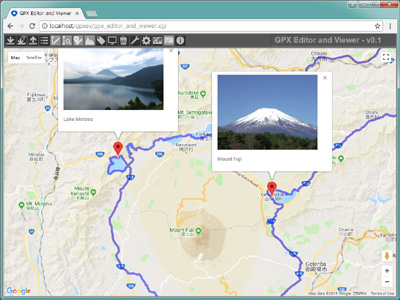
* View the results of averaging or reducing tracks, before accepting the results.ĭocumentation is available via the thorough help system within the app. * Take the average of 2-5 tracks, to even out the errors, or, for example, to establish a street's center line from tracks for the sidewalks on either side of the street.

Step 1 (as kFly mentions above): To open your GPX track, go to Add Vector Layer (in the menubar: Layer > Add Layer) and browse to your GPX file. * Eliminate superfluous trackpoints, with the option of preserving junction points against elimination. This solution is a little simpler than the others, can be done with just two QGIS tools, and there is no need to manually edit the GPX file. * Connect tracks to form 3-way and 4-way junctions, with the same coordinates in each track that meets at the junction point, to establish the topology of a network of tracks. Your tracks and waypoints are displayed over the (optional) background of a Google Map, either the default road map or a satellite image. Use your trail map for navigation, with or without an Internet connection. GPX Editor is a graphical editor for GPX (GPS Exchange Format) files, which allows users to create, view, edit, and analyze GPX files. Record tracks, or import tracks from GPX files.Ĭlean up your track data, manually and/or automatically. The Track Guru tool is used to analyze the GPS tracks in GPX files.
#Gps gpx editor mac os
It is a free and open source program that is available for Windows, Mac OS X, and Linux. Oh, this looks like a very nice programming project.Make your own trail maps, using your tablet or smartphone. The GPS Track Editor is a program that allows users to edit their GPS tracks. Depending on the distance between your data points it is quite improbable that you have one single "dip" or "spike" in between them as you normally don't ride mogul piste like ways with bumps of several meters height in it.So you could restrict the averaging to data points where a threshold slope is exceeded. The fraction (height_(i+1)-height_i)/(tracklength_(i+1)-tracklenght_i) between the data points i and i+1 is exactly the representation of this slope. A more sophisticated approach was to do some assumptions: the slope that you are able to ride on is somewhat limited and therefore only slopes smaller than a max_slope should occur in your height profile.The most simple thing would be to just parse through your GPS track data and do a moving mean value calculation which replaces every data point by the mean of lets say the the data point and its neighbours or event next-nearest neighbours.Basically you'll be 'tracing over' the GPX track in OSM, recording the path as it should be, rather than the path with all the (potentially unwanted) details recorded in the GPX.

#Gps gpx editor manual
From your profile I would guess that you have some programming skills so you could build a nice little tool that tries to flatten the curve a bit for you without the need to upload it to some website where you don't know what they are using your data. The expectation is that you will load your GPX track into an OSM editor, and then make manual adjustments to the OSM data based on your GPX track. Plan your travels, create a restaurant wish list or check out a bike track downloaded from the.

I cannot tell exactly but to me as a physicist this looks like the height curve has just a huge noise on it. Atlas is an easy to use, yet powerful GPX viewer and editor. The question is rather old but as I stumbled upon it, some thoughts:


 0 kommentar(er)
0 kommentar(er)
